A 70th birthday salute to the comics master — by Fred Van Lente…
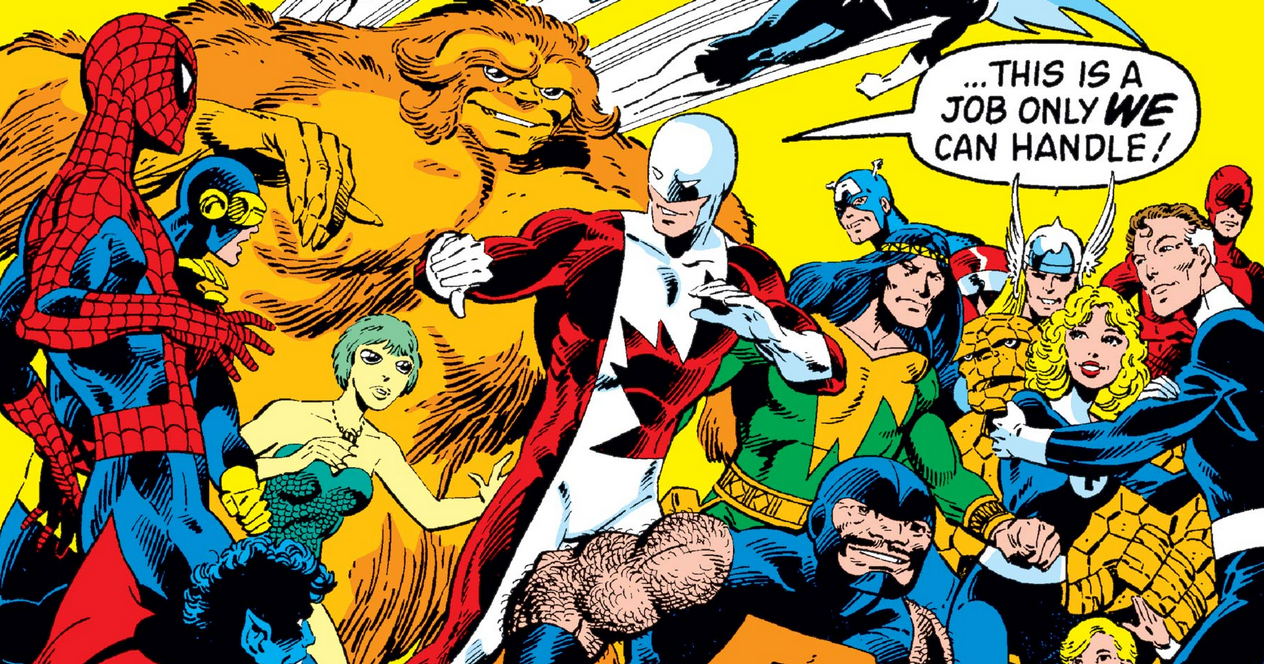
John Byrne – born July 6, 1950 — one of comics’ most popular (and at times controversial) artists and writers, is turning 70.
Traditionally, on Byrne’s birthday we run a piece about WHY JOHN BYRNE’s SUPERMAN IS THE GREATEST MAN OF STEEL. (Which is true – and you can click here to read about that.)
But we have more material this year – namely comics writer and historian Fred Van Lente’s ranking of the TOP 13 ALPHA FLIGHT STORIES EVER.
So let’s take off to the Great White North, eh?
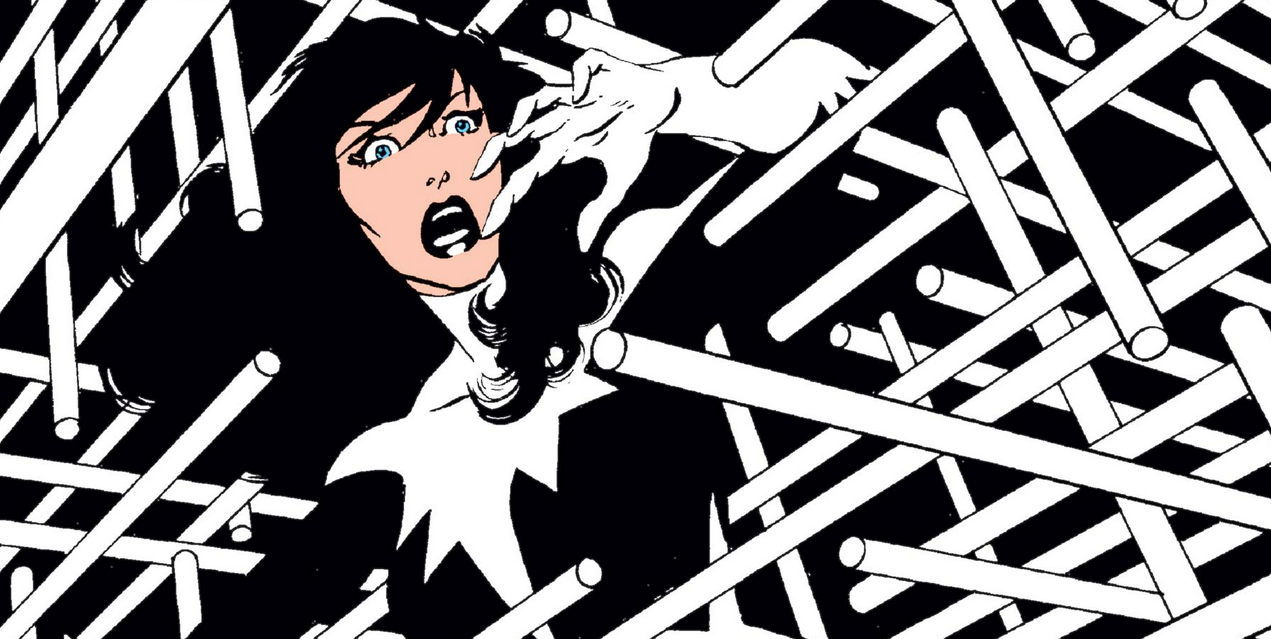
By FRED VAN LENTE
Happy Birthday to John Byrne, one of the most popular and influential writer/artists of superhero comics ever. I toyed briefly with trying to rank his Fantastic Four run (and, assuming I’m still writing these columns in 2021, one day will), but, honestly, his Alpha Flight was probably my favorite comic of my tween years. When I was 12, I doubt I could have found Canada on a map, but the dynamic Puck cover for the fifth issue leapt off the drug store spinner rack and into my hands. I read it until it fell apart.
Alpha Flight was invented basically to give Wolverine enemies from his backstory, which is hilarious to contemplate today, when he has 70,000 of those, but this is back when his origin was impenetrably mysterious, as opposed to just impenetrable. Very un-Canadian-ly deciding Logan is their personal property after training him and then losing him to Professor X, the government orders their official superhero team to get him back. To everyone’s surprise, including, apparently, Byrne’s, the Alphans were instant fan-favorites and in less than four years had graduated to their own series, written and drawn by their creator.
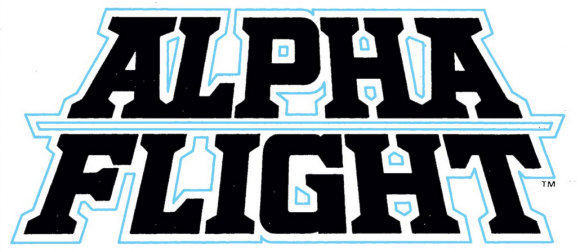
Byrne’s genius in Alpha Flight’s solo title, launched in 1983, was to take high-angst melodrama, a Marvel mainstay ever since the Thing first took a swing at Reed Richards (Page 12, Panel 6, Fantastic Four #1: I checked) and crank the dial up to 11. Alpha Flight is what happens when the DSM-5 tries to cosplay. Every member of the team has deep-seated sexual problems, is possessed by demons, flies into homicidal rages, is an ex-terrorist, hates their parents, is hated by their kids, suffers hourly pain from a genetic disorder, or, often, several of those at once. As a sensitive pre-teen I gobbled this stuff up with a spoon—and, of course, I fell in love with Byrne’s lovely, clean linework and terrific sense of design.
Alpha Flight is such a hot mess that when it teamed up with Spider-Man, that angstiest of Marvel heroes, Peter threw up his hands and ran away as fast as he could. I guess I could make some grand pronouncement about how this reflects the self-deprecating nature of the Canadian character, but art reflects artists, not nations. I have a sneaking suspicion that as a member of the first full generation of fan-turned-pro comics creators, Byrne had a reverence for the Fantastic Fours and Supermans of his childhood that he didn’t have for his own creations, so he had no compunctions about putting them through hell.
Glad he did, too. These are some great comics, and I was honored to co-write their series myself. Here’s my TOP 13 favorite comics from when John Byrne was running Alpha Flight:
—
13. Uncanny X-Men #121: Shootout in the Stampede! After forcing the X-Jet to land in Canada the previous issue, the Alphans capture Nightcrawler and Wolverine and hold them hostage in the Calgary Stampede’s rodeo arena, luring Cyclops & Co. into a confrontation so… Alpha Flight can yell at the X-Men to leave the country?
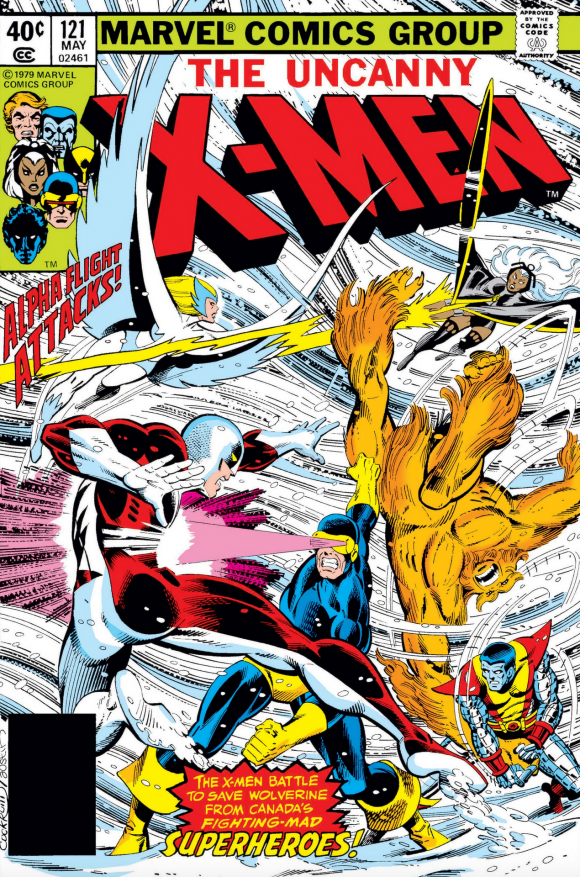
Dave Cockrum pencils, Terry Austin inks
Wait, what? Couldn’t Alpha have just taken Wolverine back to Ottawa or wherever and left Nightcrawler behind? While a nice guy and a terrific designer of electromagnetic super-suits, Alpha Flight leader Guardian/Vindicator/Weapon X is not exactly superherodom’s shrewdest tactician. To Claremont and Byrne’s credit they rattle off the new heroes as distinct, (mostly) interesting personalities, so it’s no wonder fans took to them immediately. The Birthday Boy himself even makes a cameo inside Calgary Tower’s revolving restaurant (which is still quite nice, I’ve eaten there).
—
12. Alpha Flight #15: Blind Date. Byrne created the character of Marrina to represent the Maritimes, but she didn’t really get to do much other than get captured by the Master, Alpha’s techno-Vandal Savage nemesis, and be one of the members of the team who flies into a bestial rage to murder her teammates. She gutted fellow noob Puck in their second appearance, and now here’s the rematch, inspired by the Master having found another member of her alien species. My favorite part of the issue is how her boyfriend the Sub-Mariner comes upon them fighting and his first impulse is to smack the shit out of the dwarf, not the slavering space monster. Oh, Namor. Will you ever make good choices?
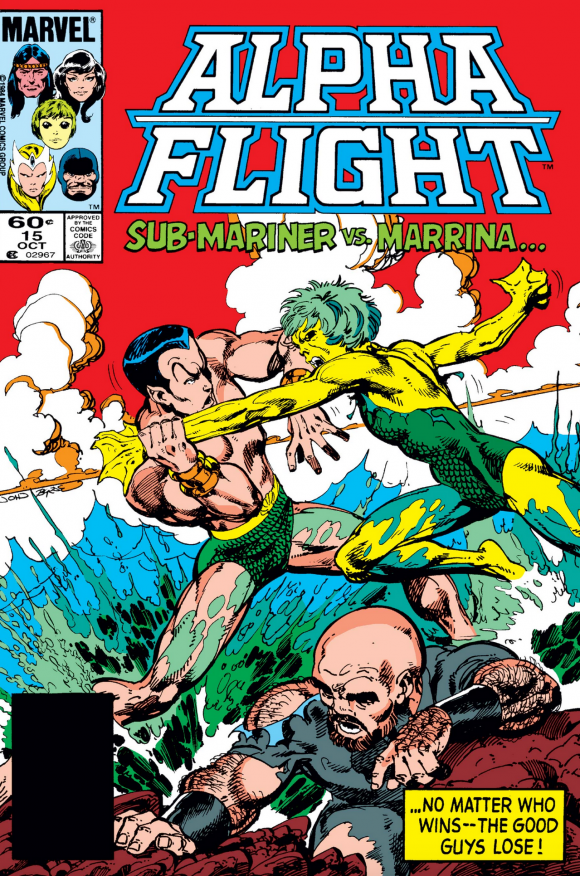
Byrne
—
11. Alpha Flight #13: Nightmare. Fun fact: Uncanny X-Men #139, with its famous “Welcome to the X-Men, Kitty Pryde” cover, is not just the first appearance of Heather Hudson, it is also the first time anyone calls Wolverine “Logan,” that anyone being Heather. Guardian’s wife becomes one of the most compelling characters in the series, the rare non-powered individual that is as — if not more — interesting than the costumed heroes around her. In this issue, though, after suffering unspeakable tragedy (and the titular silent nightmare sequence incredibly rendered by Byrne), she’s feeling especially mortal—and begins to understand that true power comes from within.
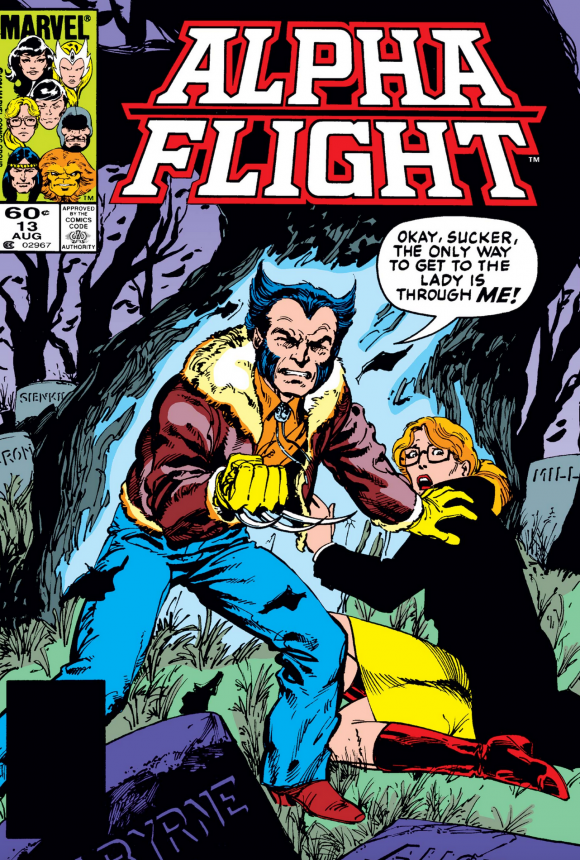
Byrne
—
10. Alpha Flight #10: Blood Feud. This is just a great old-fashioned superhero slugfest, with Sasquatch and the Super-Skrull whaling the crap out of each other in the ruins of in an Arctic research station, made all the more interesting by the fact that Kl’rt has accidentally driven Walter Langowski into a bestial rage, so the whole fight is from the alien bad guys’ point of view. All the issues where Byrne gets to draw Sasquatch smashing stuff are great, but this one’s my favorite.
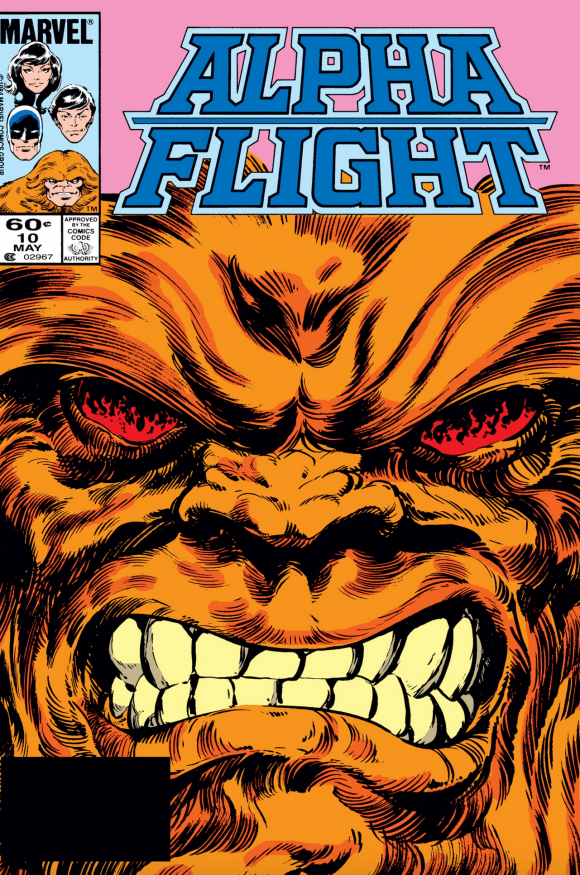
Byrne
—
9. Alpha Flight #27: Betrayal. For his swan song on the title, Byrne pulled the impressive magic trick of fooling 13-year-old me into thinking he had brought Guardian back to life with an explanation so spectacularly dumb, involving sentient jellyfish from Ganymede and time travel, that I was convinced it had to be true. The next issue —psych! — we learn it was all BS, and “Guardian” is actually a robot duplicate heralding the return of the evil Omega Flight. With half of Alpha already defeated, the second half gets lured into a trap. Then the robot gets the bright idea to turn Shaman’s medicine pouch inside out, and some mind-bending insanity ensues. The knock against this issue is that its central conflict gets resolved in Secret Wars II #4, a deeply terrible comic book in which the Beyonder god-stalks Dazzler until she falls in love with him, but I won’t hold that against it.
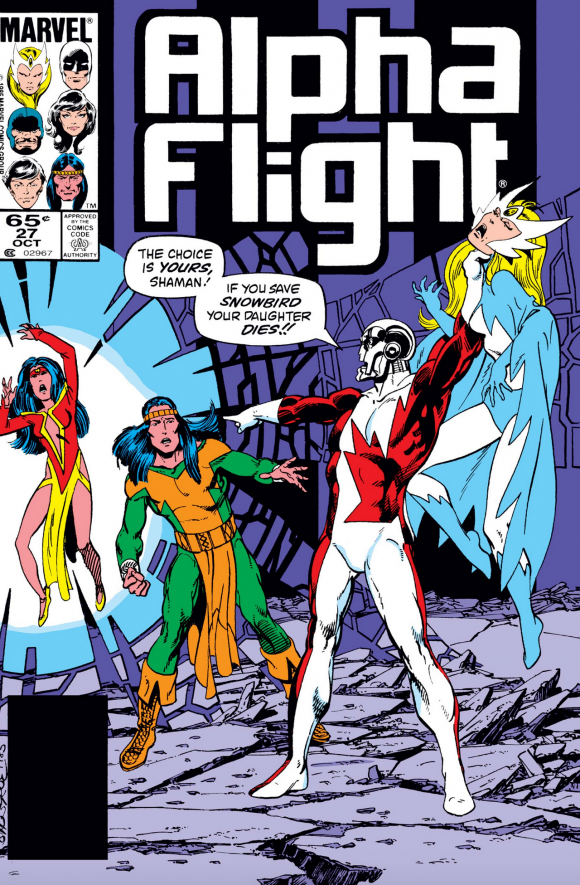
Byrne
—
8. Alpha Flight #3: Yesterday Man. First off, this is, without doubt, in my Top 3 favorite comic book covers of all time. Negative space FTW.
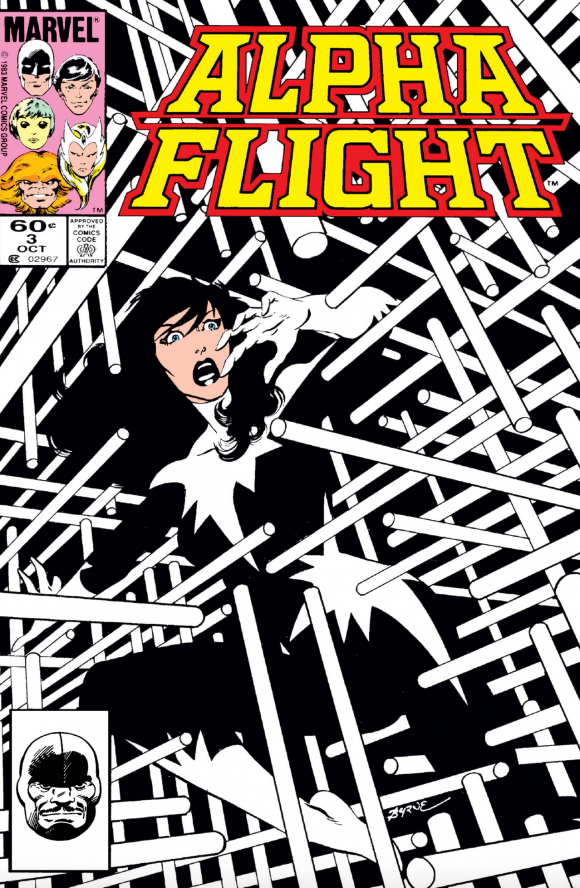
There’s an old story that Byrne came up with Aurora’s split personality because he didn’t like how she was depicted in an issue of Machine Man two weeks before AF #1 came out. I reread that issue too and I have no idea what his problem might have been, other than that colorists still hadn’t figured out what color her hair is. But then Byrne was never one to shy away from a continuity pissing match (which from my own time in the four-color sausage factory I can attest is absolutely A Thing) so now we have fun-loving floozy Aurora, who is always in conflict with the other “her,” Catholic prude Jeanne-Marie. We first see that split here, and the ease with which Byrne depicts the warring personalities is a testament to his skills as a cartoonist.
There are probably way too many origin stories in that first year of Alpha Flight: in addition to back-ups in every issue, we get a full issue of Marrina’s origin in #2, and here is the Master’s — but the Master’s origin story is about a caveman hijacked by an alien spaceship and is pretty damn cool.
—
7. Alpha Flight #18: How Long Will a Man Lie in the Earth ‘Ere He Rot? (The title is from Hamlet, I had to look it up.) Shaman’s estranged daughter Elizabeth recruits him to solve a supernatural mystery, they fight a scrambled eggs monster, then he realizes she is a mystical Chosen One. The interplay between father and daughter showcases Byrne’s great character work. The second part of this story, a time-travel story that formally introduces Elizabeth as Talisman is top-notch too, though even as a kid I didn’t undertstand why an Indigenous sorceress would wear a vinyl showgirl dress with a giant cleavage window.
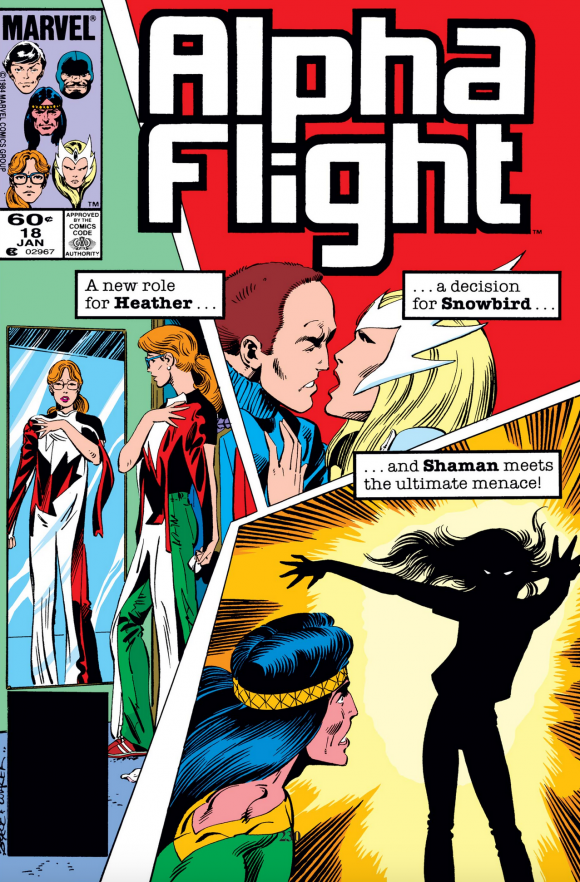
Byrne pencils, Bob Wiacek inks
There’s also a great bit where Heather calls Northstar to try and get him to rejoin Alpha Flight. He’s in his pool surrounded by hot dudes and basically tells her to go screw. One of the things I really admire about Byrne is that it’s blatantly obvious throughout the series that Northstar is gay, he just never actually spells it out (Byrne doesn’t, I mean) thereby forcing a battle with the censors.
When we were doing our first Alpha Flight issue with the great Ben Oliver, a certain high-level Marvel executive was giving us a hard time about having Northstar kiss his boyfriend at the end of the issue, which I put in the script without a second thought. This exec was thisclose to having Ben re-draw it so they were just hugging and we were like, WTF, it’s 2011, seriously? Fortunately this guy came to his senses and the issue ran with the kiss intact, but it just shows you how cutting-edge Northstar was in the early 1980s.
—
6. Alpha Flight #6: Snowblind. It wasn’t until I visited my wife’s grandparents in Sarasota that I learned “snowbird” is what they call the Canadians (or any Northerners) who flit down to the beaches every year, thereby discovering where the name of my favorite Alphan came from. Turns out John Byrne apparently created Snowbird when he was a kid, and she has an elemental, childlike quality to her, the daughter of a fictional Indigenous goddess (Nelvanna, also the name of the first Canadian superhero) who took the form of a blonde beauty to bang some random white dude.
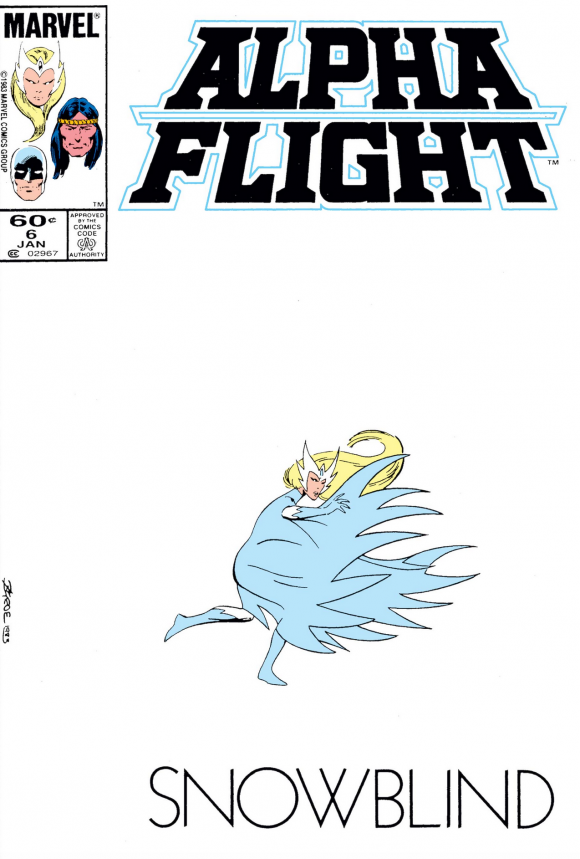
Byrne
The high concept here is that one of the Great Beasts, the demons Snowbird was conceived to battle, has trapped her in a snowstorm, so most of the story has no art, just white panels and sound effects—and a lot of descriptive captions. Supposedly Byrne was inspired by Frank Miller saying he wanted to do a Daredevil issue from Matt Murdock’s POV (i.e., all black panels, sound effects and radar sense) . This issue isn’t as effective as it could be because Byrne the Writer keeps stepping on Byrne the Artist’s clever layouts, but it’s pretty great nonetheless.
—
5. Alpha Flight #1: Tundra! The Top 5 of my list are all double-sized issues, befitting a team book with a bunch of complex, thoroughly damaged characters. Budget cuts shut down Canada’s official superhero team in Uncanny X-Men #140 (the issue before Days of Future Past begins), so when a giant sod-monster summoned by Snowbird’s deadbeat dad gets up and starts killing everyone he finds (it’s Northern Canada, so it takes him a while to find anyone) Guardian has to take the beast on himself. His wife Heather decides to get him some back-up by summoning the rest of the team, and afterward the Alphas decide to stick together on their own without government support. Maybe if they knew what was in store for them they would’ve gone their separate ways?
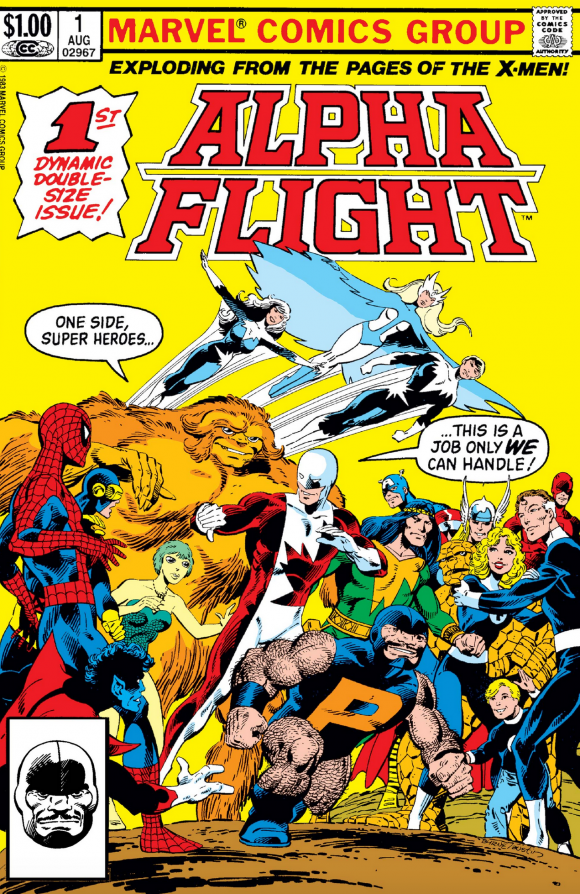
Byrne pencils, Austin inks
—
4. Alpha Flight #24: Final Conflict. Though the Master and Omega Flight have excellent claims to the title, IMHO Alpha’s true arch-enemies are the Great Beasts, kaiju-sized demons imprisoned beneath Canadian soil by the Northern gods many thousands of years before. (I had a kick creating my very own Great Beast when I was doing Incredible Hercules with Greg Pak and friends.) Alpha came back together to fight one of them, Tundra, in the first issue of the series, and the Beasts have bedeviled the team throughout the series. Last issue we learned that Sasquatch isn’t a gamma beast like the Hulk as they thought—Walter Langowski’s attempt to recreate Bruce Banner’s experiments in fact fused him with one of the Beasts, forcing Snowbird to kill him. In this issue, Alpha finally takes the fight directly to the realm of the Beasts, brilliantly conceived and designed by Byrne. As per usual, though, Alpha’s dysfunctions very nearly sink the whole enterprise.
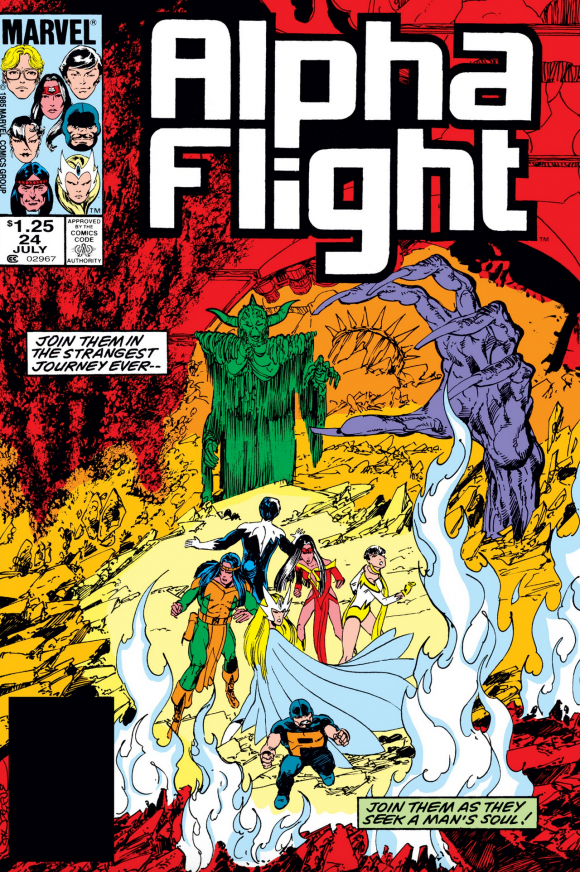
Byrne
—
3. Alpha Flight #12: …And One Shall Surely Die. I’ll confess to having zero interest in the X-Men as a kid so I had no inkling that the impact the death of Jean Grey had on fandom until I was older. But when I was 12, the shocking death of Guardian in this issue absolutely gutted me.
Comparing the two Byrne-drawn superhero deaths, I feel like I have to point out that Jean got knocked off in a couple panels squeezed into an already existent issue by editorial decree, while having reread the entirety of his run for this column it’s pretty obvious Byrne was building toward Guardian’s death the whole time, and that makes all the difference. (One wonders if the tacked-on nature of Jean’s death in the comics is partly why no one has yet been able to make a decent movie about it.)
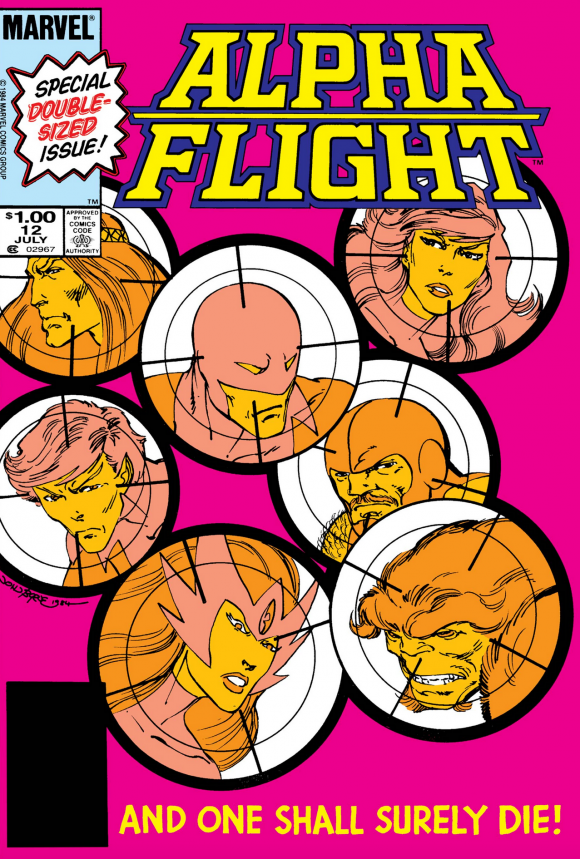
Byrne
In brief: An old enemy has lured James and Heather Hudson to New York City to kill them with the help of Omega Flight, the embittered superhumans who got cut loose when the government shut down their program. Alpha Flight shows up to save them, but all of their various internal problems that the series has been exploring up until this point crash in on them at once. Even though it looks like they just manage to pull out a last-second victory, they win the battle but lose the war. Like all great tragedies, the story has the feeling of a runaway freight train, unstoppably rolling under its own power to inevitable doom.
—
2 and 1. X-Men/Alpha Flight #1-2: The Gift, Parts 1-2. While Byrne’s Alpha Flight series is more than the sum of its parts, a completely different creative team told the best individual story about his creations during his run. Here, Chris Claremont and Paul Smith work from a story credited to Marvel EIC Jim Shooter, X-editor Ann Nocenti and Alpha editor, the late, great Denny O’Neil.
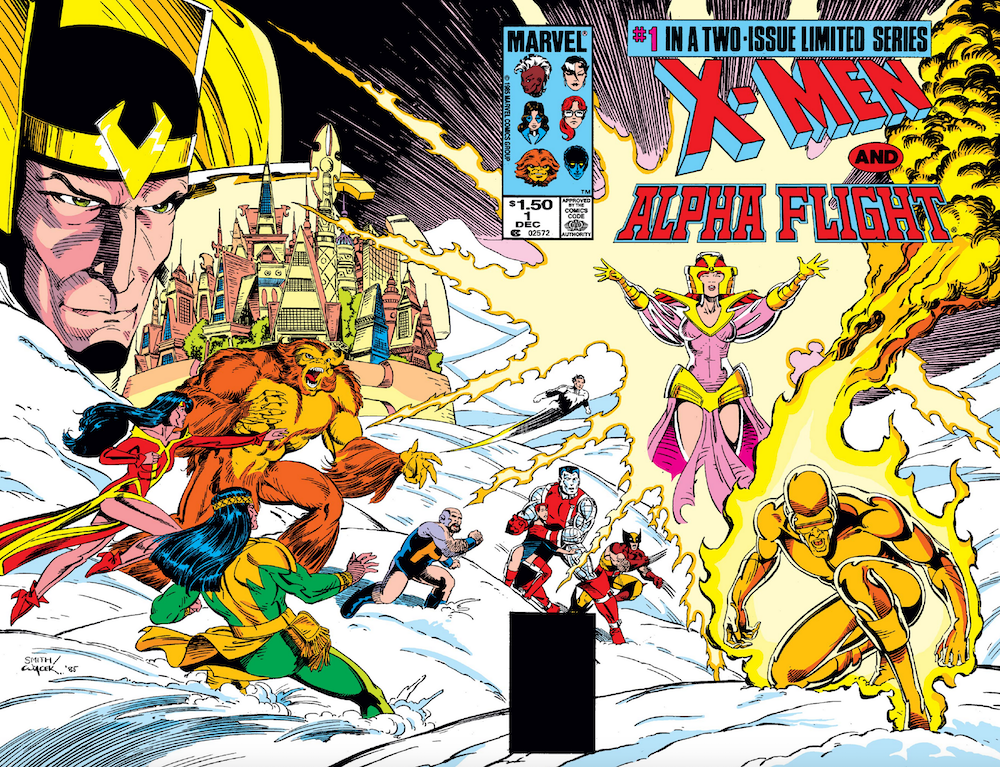
Paul Smith pencils, Wiacek inks
Cyclops and gal pal Madeline Pryor crash-land atop a long-abandoned Viking settlement in northern Quebec, bringing both super teams running. They discover a mystic fountain that makes regular humans superhuman, “heals” superhumans of whatever ails them…and, uh, kills anyone with magic, like Shaman and Snowbird. The fault lines between the heroes are soon drawn between those who think this too much of a sacrifice (Kitty Pryde, Northstar, Professor X and Talisman among the notables) and those who believe the death of a few outweighs saving the entire human race from little things like starvation and disease. That this “gift” comes from Loki for his own selfish reasons ends up tilting things in the dissenters’ favor, but not before a lot of feelings are hurt and long-concealed wounds are exposed.
Byrne was very good at breaking his characters, but the opportunity to put them back together provides their most compelling tale.
—
MORE
— JOHN BYRNE’s Complete GENERATIONS Saga to Get Omnibus Treatment. Click here.
— Why JOHN BYRNE’S SUPERMAN Was the Greatest Man of Steel Ever. Click here.

July 6, 2020
Happy birthday, Mr. Byrne!
July 6, 2020
I was with you through #3, but I found the (recently-read) X/AF to be pretty much unbearable. None of the characters felt right, and the Loki-driven plot seemed like an odd choice for either team. It was good to see Smith’s X-Men again, tho (his take on AF not so much).
December 2, 2022
Despite how much I enjoyed it when it came out, I had a similar sense at the same time. I’m not bothering to include it in my present reading of #8-soon-to-be-#28. I’m thinking about Byrne’s structure, but I hadn’t considered what a stew of mental issues did drive them. I guess I get my love of the comic confused with them actually liking each other: in #24, we get a line from Puck that makes sense- Sasquatch can be a pain in the ass about the size thing- in that he isn’t the one to Hate Langkowski (rarely ‘Walt’), but doesn’t particularly like him. I thought the ribbing to be more good-natured. Puck does like to take up a bit of the chip on the shoulder. It’s something I like about him!
#24, by the way, really made me wonder if Shaman was Byrne’s favorite: it’s a finest hour for Michael, maybe for John B, too. I originally had #12 and didn’t get to read anything else until a friend loaned me #24, 26 and 27. Oh, that eleven year-old was hooked!
I’m going back to your list, Dan, but I really enjoyed the intro! The use of origins and sub-groups so well here inspires me to keep that element abundant in my own Sunstrike work. The first game-story module is Sunstrike’s origin, and I could continue threading origins through each of my first games.
July 6, 2020
This is one series I tried that I didn’t stay with long. Can’t say anything bad about the art but the story never caught me.
July 8, 2020
I agree that finding a way to put original Alpha Flight back together again—quirky and unpredictable but still Canada’s Premier Super-Team—remains their greatest untold story.
November 20, 2020
A thorough reminder of just how striking and original Alpha Flight was. Great read!
April 15, 2022
Congrats Fred
I see you are very knowledgeable, I can tell you, I am a big fan of Byrne, I followed him, the best I could, from Marvel to DC’s Superman. It was not a huge deal for me, as I did not have any idea how this worked, I am from México, so these news were almost old news to me.
However, I was hooked with comic books from the 70’s, always been a Star Wars fan, so the 6 issues mini series for the movie was a big hit for me and started to see the art on those comic pages.
Years later I saw John’s work in the pages of Marvel comics but you can imagine my surprise when I discovered in late 80’s that John Byrne made Superman, wow!
Anyways, thanks for this posts, I really enjoyed them!
December 2, 2022
If I had a problem with #11-12, it was the motivation for very cool-to-watch Omega Flight, themselves, even with Delphine Courtney’s ‘persuasion.’ But I deduce DC influenced Heather in that fakeout in #23 and will use that ability again, briefly.
And maybe I didn’t read carefully enough, but I find myself wondering: considering his thoughts in #12, why didn’t Michael reach out to Walter sooner with his suspicions? The practical answer, of course, would’ve been for Walter to stop transforming until they could verify what was going on, which would’ve then been indefinitely, short of a similar assault against the Great Beasts. Maybe Snowbird would’ve attacked him sooner, then. Byrne does make Shaman wise and discerning, but he does weight his words carefully, and is not omniscient. I guess there was simply another way there, and cannot argue that this way made for visceral comics!
On that note, I love the careful scripting of these many strange predicaments. I might not find his characters quite as inherently likeable as Gerber’s, but I do see the hypothesis that Alpha Flight is a true successor to his Defenders.
February 11, 2023
I love byrne’s run on Alpha Flight my only problem is he broke many of his own rules as far as not changing a book too much it cant go back to status quo. He basically threw a grenade at the group and left the next writer to clean it up. The ups and downs made for good stories but it drastically altered who they were.
December 2, 2022
I realize this #13, like many guest spots, was actually written by Volume 4’s co-author, so I don’t know if Fred directly responds on Dan’s comments.
Oh, snap, I’d not thought about this in a while, but they were created each to represent Provinces! Good an inspiration as any to get a pattern.
I have to agree with Hudson’s approach to Logan- that bugged me in #122! It’s such a colorful battle, just, eh. Was he subconsciously jealous of Logan and Heather’s connection, or did this just feed into his need to prove Wolvie’s equal? That’s one of the AF primary drivers- until Heather’s brought more clearly to the fore as the team’s emotional patron and guide.
Yes, who couldn’t love that #3 cover? A slim spectrum hungry for more potential or depicted violence, I guess, but if you ever imagined what it is to be up close to Aurora, her peril’s got a visceral connection. And if you realize the nature of her powers, you can feel what a trap that is for her, too! You empathize, as most would, based on body language- and all designed to feature black, and white.